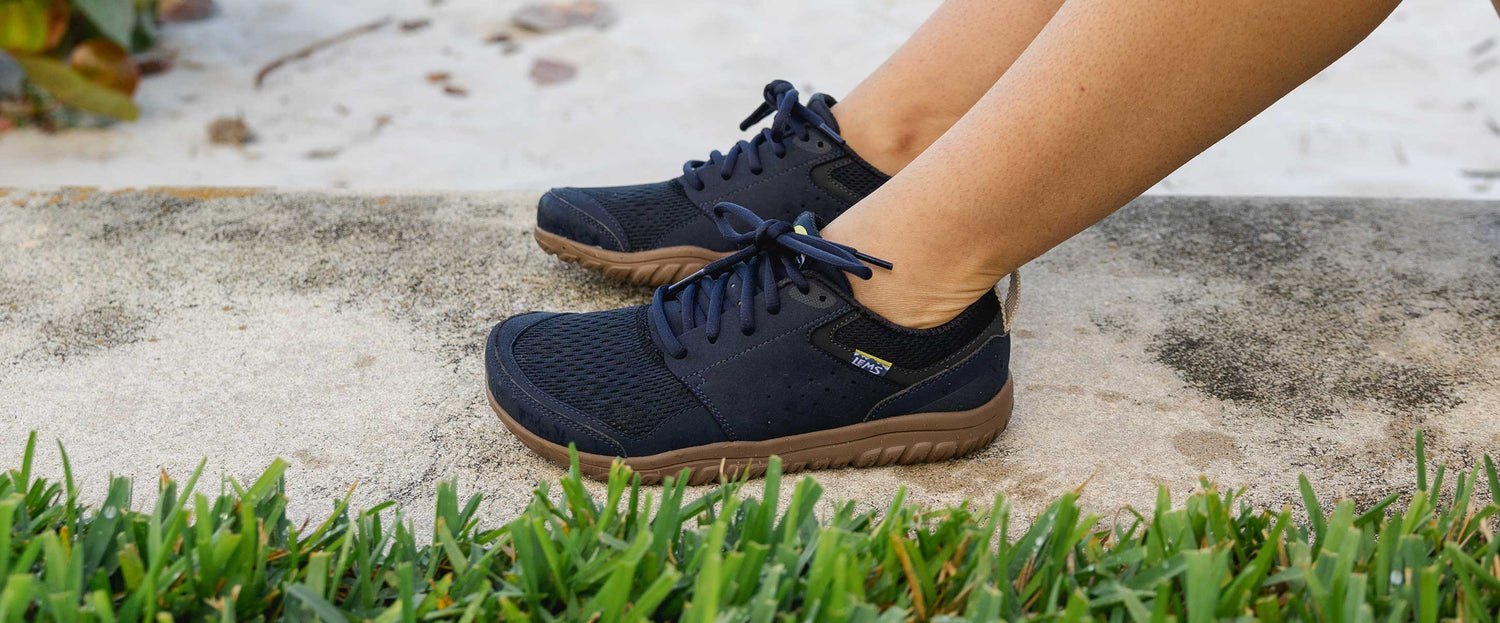The Problem with Traditional Athletic Shoes
For decades, sneaker companies have marketed the idea that more is better—more cushioning, more support, more technology. The assumption has been that adding thick soles, rigid arch support, and reinforced heels would make shoes better for movement, better for performance, and better for comfort. But as more research emerges and people start questioning these claims, a new reality is coming to light: traditional sneakers may actually be doing more harm than good.
Most athletic shoes force the foot into an unnatural position. Raised heels shift body weight forward, thick midsoles dull the foot’s sensory connection to the ground, and narrow toe boxes prevent natural toe splay, limiting balance and stability. The irony? These shoes are marketed as protective, but they can actually weaken foot muscles over time, leading to a reliance on artificial support rather than allowing the body to develop its own natural strength.
Many people experience foot pain, knee discomfort, and even back issues without realizing that their bulky sneakers could be the root cause. When shoes don’t allow feet to move the way they were designed, imbalances develop. The body compensates, often in ways that lead to discomfort or injury down the road. Instead of helping the foot function as it was meant to, traditional sneakers restrict movement, creating a cycle of dependence on overbuilt footwear. As more people become aware of these issues, they are starting to look for alternatives, sparking what we now call the anti-sneaker revolution.
The Science Behind Foot Freedom
The human foot is one of the most complex structures in the body, consisting of 26 bones, 33 joints, and over 100 muscles, tendons, and ligaments. It is designed to provide natural stability, shock absorption, and propulsion without the need for excessive external support. In fact, our ancestors walked, ran, and thrived for thousands of years without the cushioned, rigid sneakers that dominate today’s footwear industry.
The problem with traditional sneakers is that they override the foot’s natural ability to function as intended. When thick soles and arch supports do the work that foot muscles should be doing, those muscles weaken over time. The feet become dependent on structured shoes, and as a result, people begin experiencing common foot problems like plantar fasciitis, shin splints, bunions, and general foot fatigue.
Scientific studies support the benefits of barefoot-style movement. Research has shown that minimalist footwear, which mimics the experience of walking barefoot while still providing protection, helps strengthen the muscles of the feet and lower legs. A key aspect of this is toe splay, which refers to the ability of the toes to spread naturally when walking or running. In traditional sneakers, narrow toe boxes compress the toes, reducing stability and forcing the body into compensatory movement patterns. Over time, this can lead to foot deformities like bunions and hammertoes.
A wide toe box allows for proper toe alignment, improving balance and reducing pressure points. Pair this with a zero-drop sole, where the heel and forefoot sit at the same height, and you get a shoe that encourages proper posture, natural gait, and an overall healthier walking or running experience. Minimalist footwear allows the body to work the way it was designed to, rather than forcing it into an artificial mold dictated by overbuilt shoe designs.
Why More People Are Choosing Minimalist Shoes
The shift toward minimalist footwear isn’t just about following a trend—it’s about people finally finding relief from years of discomfort and foot pain. Runners who once struggled with injuries are discovering that their stride improves when they switch to minimalist shoes. Hikers are enjoying better ground feel and agility on trails. Everyday wearers are realizing that their feet feel stronger, more mobile, and more comfortable when they ditch the bulk and embrace foot-shaped designs.
One reason for this growing movement is the rise of functional fitness. As more people focus on mobility, strength training, and natural movement, they’re recognizing that the same principles apply to their feet. Just like lifting weights builds stronger muscles, allowing the feet to function naturally strengthens the foot muscles, reducing the risk of injury and promoting overall well-being.
The rise of wellness trends like barefoot training, yoga, and primal movement has also influenced the shift away from traditional sneakers. More people are paying attention to how their bodies move, how their posture is affected by their shoes, and how they feel after a long day in structured footwear. When they experience the freedom of minimalist shoes for the first time, the difference is undeniable.
How Lems Shoes Are Leading the Movement
Lems has been a leader in the minimalist footwear movement, offering shoes that promote foot health while still delivering on style, versatility, and durability. Unlike traditional sneakers that force feet into restrictive shapes, Lems designs their shoes to support natural movement from the ground up.
One of the key features of Lems footwear is the wide toe box, which allows toes to spread as they would when walking barefoot. This simple but crucial design element improves balance, reduces pressure on the joints, and prevents foot pain caused by cramped toe spaces. Paired with a zero-drop sole, which keeps the heel and forefoot on the same level, Lems shoes encourage proper posture, ensuring that the body remains aligned with every step.
Another advantage of Lems shoes is their lightweight, flexible construction. Instead of relying on thick midsoles that disconnect the foot from the ground, Lems prioritizes flexibility, allowing the foot to move naturally. Whether someone is looking for an active shoe for running and training, a rugged boot for outdoor adventures, or a casual everyday option, Lems has a design that supports a more natural way of walking and moving.
Making the Switch to Minimalist Shoes
Switching to minimalist footwear isn’t something that happens overnight. After years—sometimes decades—of wearing structured sneakers, most people’s feet have adapted to the extra cushioning and artificial support. Transitioning too quickly can lead to discomfort as the muscles in the feet and lower legs adjust to a more natural workload.
The best way to transition is to start gradually. Wearing minimalist shoes for short walks, light workouts, or casual outings allows the feet to rebuild strength. Incorporating foot exercises, like toe spreads, arch lifts, and balance drills, can further help the transition process. Over time, as foot strength increases, people find they can wear minimalist shoes for longer periods without discomfort.
Lems makes it easier to transition with a variety of styles suited for different levels of minimalism. Whether someone is looking for a flexible sneaker alternative, a lightweight trail shoe, or a rugged outdoor boot, Lems has a shoe that fits their needs.
The Future of Footwear is Minimalist
The anti-sneaker revolution is proving that less is more. Traditional sneakers, with their thick padding and rigid structures, have dominated the market for years, but more people are waking up to the fact that their feet don’t need all that excess material to function properly. Minimalist shoes provide the freedom to move naturally, strengthening the feet, improving posture, and reducing discomfort.
This movement isn’t just for runners or athletes—it’s for anyone who wants to walk, stand, and move with greater comfort and less restriction. Whether you’re looking to improve your foot health, reduce pain, or simply experience the benefits of natural movement, making the switch to minimalist shoes is a step in the right direction.
For those ready to leave bulky sneakers behind, Lems offers a smarter alternative. With foot-shaped designs, lightweight materials, and a commitment to comfort, Lems is leading the charge in changing the way people think about footwear. The future of footwear is minimalist, and the best time to make the switch is now. Your feet will thank you for it.

